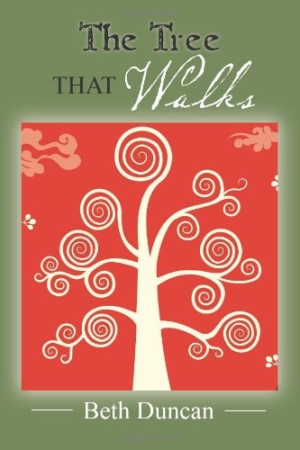The Tree that Walks
Poems of Self Integration
Equating nature to humans illumines divine elements of life in this gentle and spiritual volume.
Beth Duncan takes a look at spirituality, nature, and mortality in The Tree that Walks. Her poetry is sensitive and personal and speaks of her philosophy of integration. Duncan has observed humanity and nature, weaving them together with elements of the divine in order to illustrate their connectedness.
Many of the pieces speak literally about the similarities between bones and branches, wind and breath, skin and petals. They are graceful and inherently feminine poems, often humanizing natural elements into “sister moon” and “sister leaves.”
The first section, “Dark and Light,” is the more engrossing half of the volume, connecting the author and nature with elements beyond her control. “Touchwood,” which reflects on the death of two children during the Vietnam conflict, ends memorably:
“Now, quiet by my hearth
I watch two tiny scarlet sparks
entwine, spiral skyward, fragile
as two children’s bones.”
In another poem, Duncan brings an explosion of a sun in outer space into perspective as cosmic gusts are equated with a breath that lifts her hair in her garden. Beautiful lines and images such as these focus a lens on small moments and make them significant.
The second section, “Begin to Integrate,” is less strong and becomes repetitive. The frequent appearance of roses, leaves, and breezes become worn over the course of several poems, weakening the message of each individually. Because it is a personal journey for Duncan, her poems are also written almost exclusively in first person, and there is little variation in the style of her verse. This feels slightly alienating, particularly in the second half of the collection: “It is always at twilight / that my heart is aroused”; “In meditation I saw every vein”; “I have only words to express my restless heart”; “I rise in darkness.” From a biographical standpoint, these pieces are interesting, but Duncan seems to be trying to reach out and connect herself with others, and the barrier of so much “I” and “me” gets in her way.
Ultimately, this is a gentle and spiritual volume. Without committing herself to religion, Duncan evokes nature alongside Jesus, Nefertiti, Isis, and a host of gods and goddesses. She is very effective at using these religious references toward her goal of integration. The poem “Lazarus at Midnight” describes Duncan seeing the face of Jesus in the rain falling down her window. There is nothing about this piece that preaches Christianity; Duncan merely describes an image created by the droplets—“Long hair streams / around aquiline nose”—to express her vision of finding the divine in nature.
Duncan remained unpublished for a number of years but now shares her poetry to empower others. The Tree that Walks succeeds in making natural connections in literal and sentimental ways that clearly define the poet’s philosophy.
Reviewed by
Sara Budzik
Disclosure: This article is not an endorsement, but a review. The publisher of this book provided free copies of the book and paid a small fee to have their book reviewed by a professional reviewer. Foreword Reviews and Clarion Reviews make no guarantee that the publisher will receive a positive review. Foreword Magazine, Inc. is disclosing this in accordance with the Federal Trade Commission’s 16 CFR, Part 255.

